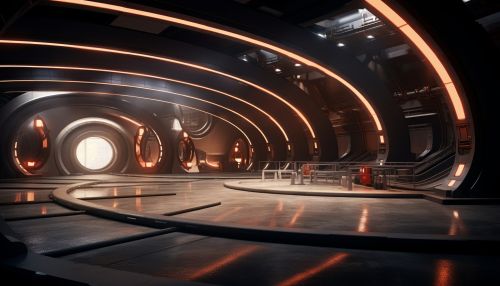Large Hadron Collider
Introduction
The Large Hadron Collider (LHC) is the world's largest and highest-energy particle collider. It was built by the European Organization for Nuclear Research (CERN) between 1998 and 2008 in collaboration with over 10,000 scientists and engineers from over 100 countries, as well as hundreds of universities and laboratories.
Design and Construction
The LHC is the world's largest single machine and the most complex experimental facility ever built. Its main ring is 27 kilometers in circumference and is located 100 meters underground. The collider uses the Super Proton Synchrotron (SPS) as a pre-accelerator. The SPS accelerates protons which are then injected into the LHC.


The construction of the LHC was approved in 1994 with a budget of 4 billion Swiss francs (equivalent to 2.6 billion Euros). The civil engineering work began in 1998 and was completed in 2003. The final element of the LHC, a dipole magnet, was lowered into the accelerator in January 2007, and the collider was cooled down to its operational temperature in January 2008.
Operation and Experiments
The LHC primarily collides proton beams, but it can also use beams of heavy ions: Pb-Pb (lead-lead) collisions and p-Pb (proton-lead) collisions. The LHC's detectors observe and record the results of these collisions, allowing scientists to analyze the data for evidence of new physical phenomena.
The LHC operates at a very low temperature. Its magnets are superconducting and need to be cooled to -271.3 degrees Celsius, which is colder than outer space. The cooling is achieved with 120 tonnes of liquid helium.
The LHC hosts several experiments, including the ATLAS and CMS, which are large general-purpose particle detectors. ATLAS and CMS were instrumental in the discovery of the Higgs boson, a particle that helps explain why other particles have mass.
Impact and Discoveries
The LHC has made significant contributions to particle physics, including the discovery of the Higgs boson in 2012 by the ATLAS and CMS experiments. This discovery was a major milestone in the field, as it confirmed the existence of the Higgs field, a fundamental field of energy that permeates the universe.
In addition to the Higgs boson, the LHC experiments have led to numerous other scientific advancements and have generated thousands of academic papers. The data from the LHC has been used to test the predictions of different theories of particle physics, including measuring the properties of the Higgs boson and searching for evidence of new physical phenomena beyond the Standard Model.
Future Plans
CERN has plans to build a successor to the LHC, the Future Circular Collider (FCC). The FCC would have a 100-kilometer circumference and would be capable of reaching energies up to 100 TeV. It is expected to be operational by 2040.
